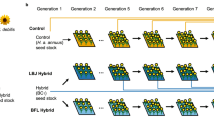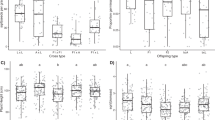Abstract
The deleterious effects of hybridization are a serious concern for the conservation and management of species, particularly when populations mix as a result of human activity. Outbreeding depression is the typical result observed in early-generation interpopulation hybrids of Tigriopus californicus. We examined both controlled crosses and long-term, freely-mating, experimental hybrid populations composed of southern California populations Royal Palms (RP) and San Diego (SD). Controlled crosses included parentals plus all reciprocal F1, F2, F3 and backcross cohorts, and only F2 cohorts showed significant declines in fitness compared to midparent values, indicating recovery in the F3. For long-term studies, four treatment groups were initiated: 100% RP, 100% SD, 50% RP: 50% SD, and 80% RP: 20% SD. Replicates were surveyed at 3-month intervals for morphometric, census and fitness measures. Fitness of hybrid treatments showed declines relative to midparent values followed by rapid recovery, with two hybrid replicates ultimately showing higher fitness than parentals at the final 15-month time-point (up to 20 generations). In contrast, both males and females in hybrid treatments were larger than the midparent for several morphometric characters at the first time-point, and smaller than the midparent at the final time-point, indicating a possible tradeoff between fitness and body size. Microsatellites for a subset of samples revealed extensive introgression in hybrid treatments. This adds to previous evidence that hybrid breakdown in early generations may be a temporary phenomenon followed by the persistence of highly fit recombinant genotypes.




Similar content being viewed by others
References
Allendorf FW, Leary RF, Sprunell P, Wenburg JK (2001) The problems with hybrids: setting conservation guidelines. Trends Ecol Evol 16(11):613–622
Arnold M (2006) Evolution Through Genetic Exchange. Oxford University Press, Oxford, UK
Bowman J, Kidd AG, Gorman RM, Schulte-Hostedde AI (2007) Assessing the potential for impacts by feral mink on wild mink in Canada. Biol Conserv 139:12–18
Brochmann C, Borgen L, Stabbetorp OE (2000) Multiple diploid hybrid speciation of the Canary Island endemic Argyranthemum sundingii (Asteraceae). Plant Syst Evol 220:77–92
Burton RS (1985) Mating system of the intertidal copepod Tigriopus californicus. Mar Biol 86:247–252
Burton RS (1986) Incorporation of 14C-bicarbonate into the free amino acid pool during hyperosmotic stress in an intertidal copepod. J Exp Zool 238:55–61
Burton RS (1987) Differentiation and integration of the genome in populations of the marine copepod Tigriopus californicus. Evolution 41:504–513
Burton RS (1990a) Hybrid breakdown in developmental time in the copepod Tigriopus californicus. Evolution 44:1814–1822
Burton RS (1990b) Hybrid breakdown in physiological response: a mechanistic approach. Evolution 44:1806–1813
Burton RS, Lee B-N (1994) Nuclear and mitochondrial gene genealogies and allozyme polymorphism across a major phylogeographic break in the copepod Tigriopus californicus. Proc Natl Acad Sci USA 91:5197–5201
Byrom AE, Burns CW, Wallis GP (1993) Experimental hybridization of apine and lowland forms Beockella dilatata, a calanoid copepod. Heredity 71:508–515
Carney SE, Gardner KA, Rieseberg LH (2000) Evolutionary changes over the fifty-year history of a hybrid population of sunflowers (Helianthus). Evolution 54:462–474
Christiansen FB (2008) Theories of Population Variation in Genes and Genomes. Princeton University Press, Princeton, New Jersey
Dowling TE, Secor CL (1997) The role of hybridization and introgression in the diversification of animals. Annu Rev Ecol Syst 28:593–619
Edmands S (1999) Heterosis and outbreeding depression in interpopulation crosses spanning a wide range of divergence. Evolution 53(6):1757–1768
Edmands S (2001) Phylogeography of the intertidal copepod Tigriopus californicus reveals substantially reduced population differentiation at northern latitudes. Mol Ecol 10:1743–1750
Edmands S (2007) Between a rock and a hard place: evaluating the relative risks of inbreeding and outbreeding for conservation and management. Mol Ecol 16:463–475
Edmands S, Burton RS (1999) Cytochrome c oxidase activity in interpopulation hybrids of a marine copepod: a test for nuclear-nuclear or nuclear-cytoplasmic coadaptation. Evolution 53:1972–1978
Edmands S, Deimler JK (2004) Local adaptation, intrinsic coadaptation and the effects of environmental stress on interpopulation hybrids in the copepod Tigriopus californicus. J Exp Mar Biol Ecol 303:183–196
Edmands S, Harrison JS (2003) Molecular and quantitative trait variation within and among populations of the intertidal copepod Tigriopus californicus. Evolution 57:2277–2285
Edmands S, Timmerman CC (2003) Modeling factors affecting the severity of outbreeding depression. Conserv Biol 17:883–892
Edmands S, Northrup SL, Hwang AS (2009) Maladapted gene complexes within populations of the intertidal copepod, Tigriopus californicus. Evolution 63(8):2184–2192
Edmands S, Feaman HV, Harrison JS, Timmerman CC (2005) Genetic consequences of many generations of hybridization between divergent copepod populations. J Hered 92:114–123
Egloff DA (1966) Ecological aspects of sex ratio and reproduction in experimental and field populations of the marine copepod Tigriopus californicus. Dissertation, Stanford University
Ellstrand NC, Schierenbeck KA (2006) Hybridization as a stimulus for the evolution of invasiveness in plants? Euphytica 148:35–46
Erickson DL, Fenster CB (2006) Intraspecific hybridization and the recovery of fitness in the native legume Chamaecrista fasciculata. Evolution 60:225–233
Fenster CB, Galloway LF (2000) Inbreeding and outbreeding depression in natural populations of Chamaecrista fasciculata (Fabaceae). Conserv Biol 14:1406–1412
Ganz HH, Burton RS (1995) Genetic differentiation and reproductive incompatibility among Baja California populations of the copepod Tigriopus californicus. Mar Biol 123:821–827
Gilk SE, Wang IA, Hoover CL, Smoker WW, Taylor SG, Gray AK, Gharrett AJ (2004) Outbreeding depression in hybrids between spatially separated pink salmon, Oncorhynchus gorbuscha, populations: marine survival, homing ability, and variability in family size. Environ Biol Fishes 69:287–297
Gow JL, Peichel CL, Taylor EB (2006) Contrasting hybridization rates between sympatric three-spined sticklebacks highlight the fragility of reproductive barriers between evolutionarily young species. Mol Ecol 15:739–752
Grant PR, Grant BR (1992) Hybridization of bird species. Science 256:193–197
Haldane JBS (1922) Sex ratio and unisexual sterility in animal hybrids. J Genet 12:101–109
Harrison JS, Edmands S (2006) Chromosomal basis of viability differences in Tigriopus californicus interpopulation hybrids. J Evol Biol 19(6) 2040–2051
Harrison JS, Peterson DL, Swain JR, Edmands S (2004) Microsatellite DNA markers for the intertidal copepod Tigriopus californicus. Mol Ecol Notes 4:736–738
Hedrick PW, Fredrickson R (2010) Genetic rescue guidelines with examples from Mexican wolves and Florida panthers. Conserv Genet 11:615–626
Houde ALS, Fraser DJ, Hutchings JA (2010) Reduced anti-predator responses in multi-generational hybrids of farmed and wild Atlantic salmon (Salmo salar L.). Conserv Genet 11(3):785–794. doi:10.1007/s10592-009-9892-2
Hutchings JA, Fraser DJ (2008) The nature of fisheries-and farming-induced evolution. Mol Ecol 17:294–313
Huxley J (1928) Sexual difference of linage in Gammarus chevreuxi. J Genet 20:145–156
Johnson JR, Fitzpatrick BM, Shaffer HB (2010) Retention of low-fitness genotypes over six decades of admixture between native and introduced tiger salamanders. BMC Evol Biol 10:147
Lynch M (1991) The genetic interpretation of inbreeding depression and outbreeding depression. Evolution 45:622–629
McGinnity P, Prodohl P, Ferguson A, Hynes R, O’Maoileidigh N, Baker N, Cotter D, O’Hea B, Cooke D, Rogan G, Taggart J, Cross T (2003) Fitness reduction and potential extinction of wild populations of Atlantic salmon, Salmo salar, as a result of interactions with escaped salmon. Proc R Soc London, Ser B 270:2443–2450
Muhlfeld CC, Kalinowski ST, McMahon TE, Taper ML, Painter S, Leary RF, Allendorf FW (2009) Hybridization rapidly reduces fitness of a native trout in the wild. Biol Lett 5:328–331
Palmer CA, Edmands S (2000) Mate choice in the fact of both inbreeding and outbreeding depression in the intertidal copepod Tigriopus californicus. Mar Biol 136:693–698
Randi E (2008) Detecting hybridization between wild species and their domesticated relatives. Mol Ecol 17:285–293
Raymond M, Rousset F (1995) GENEPOP (version 1.2) population genetic software for exact tests and ecumenicism. J Hered 86:248–249
Rieseberg LH, Sinervo B, Linder CR, Ungerer MC, Arias DM (1996) Role of gene interactions in hybrid speciation: evidence from ancient and experimental hybrids. Science 272:741–745
Rieseberg LH, Archer MA, Wayne RK (1999) Transgressive segregation, adaptation and speciation. Heredity 83:363–372
Roberge C, Normandeau E, Einum S, Guderley H, Bernatchez L (2008) Genetic consequences of interbreeding between farmed and wild Atlantic salmon: insights from the transcriptome. Mol Ecol 17:314–324
Schwarzbach AE, Rieseberg LH (2002) Likely multiple origins of a diploid hybrid sunflower species. Mol Ecol 11:1703–1715
Seehausen O, Takimoto G, Roy D, Jokela J (2008) Speciation reversal and biodiversity dynamics with hybridization in changing environments. Mol Ecol 17:30–44
Tallmon DA, Luikart G, Waples RS (2004) The alluring simplicity and complex reality of genetic rescue. Trends Ecol Evol 19:489–496
Taylor EB, Boughman JW, Groenenboom M, Sniatynski M, Schluter D, Gow JL (2006) Speciation in reverse: morphological and genetic evidence of the collapse of a three-spined stickleback (Gasterosteus aculeatus) species pair. Mol Ecol 15:343–355. doi:10.1111/j.1365-294X.2005.02794.x
Templeton AR (1986) Coadaptation and outbreeding depression. In: Soule ME (ed) Conservation biology, The science of scarcity and diversity. Sinauer Associates, INC, Sunderland, MA, pp 105–116
Vittor BA (1971) Effects of the environment on fitness-related life history character in Tigriopus californicus. Dissertation, University of Oregon
Weir BS, Cockerham CC (1984) Estimating F-statistics for the analysis of population structure. Evolution 38(6):1358–1370
Willett CS (2010) Potential fitness trade-offs for thermal tolerance in the intertidal copepod Tigriopus californicus. Evolution. doi:10.1111/j.1558-5646.2010.01008.x
Acknowledgments
This work was funded by grants to S.E. from the U.S. National Science Foundation (DEB-0316807) and USC’s Women in Sciences and Engineering Program.
Author information
Authors and Affiliations
Corresponding author
Rights and permissions
About this article
Cite this article
Hwang, A.S., Northrup, S.L., Alexander, J.K. et al. Long-term experimental hybrid swarms between moderately incompatible Tigriopus californicus populations: hybrid inferiority in early generations yields to hybrid superiority in later generations. Conserv Genet 12, 895–909 (2011). https://doi.org/10.1007/s10592-011-0193-1
Received:
Accepted:
Published:
Issue Date:
DOI: https://doi.org/10.1007/s10592-011-0193-1




